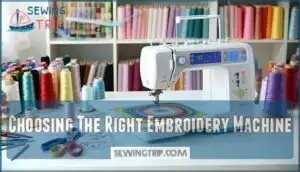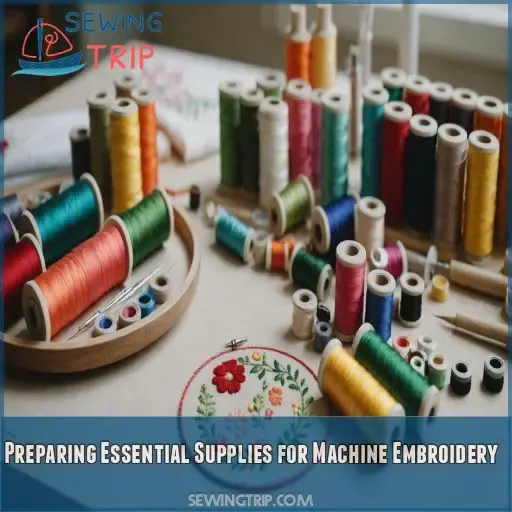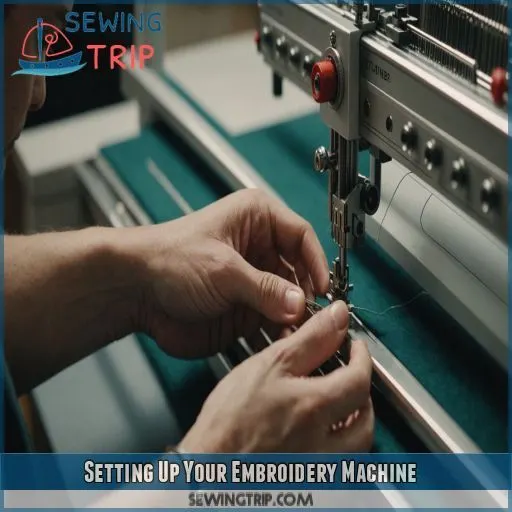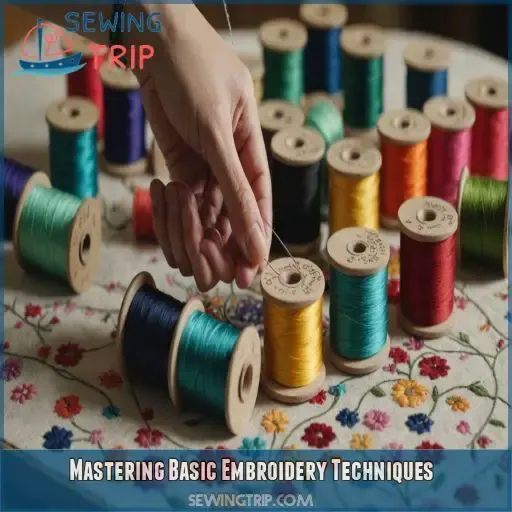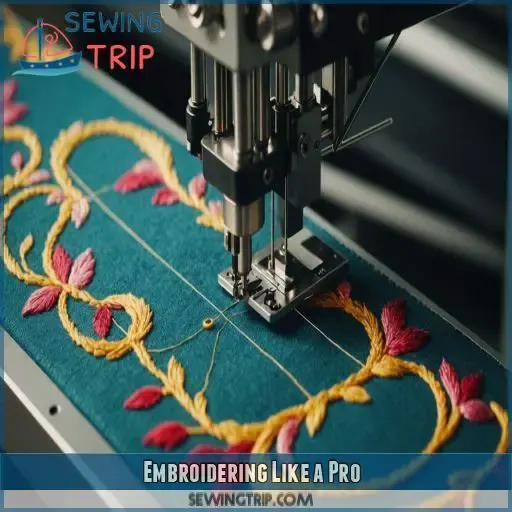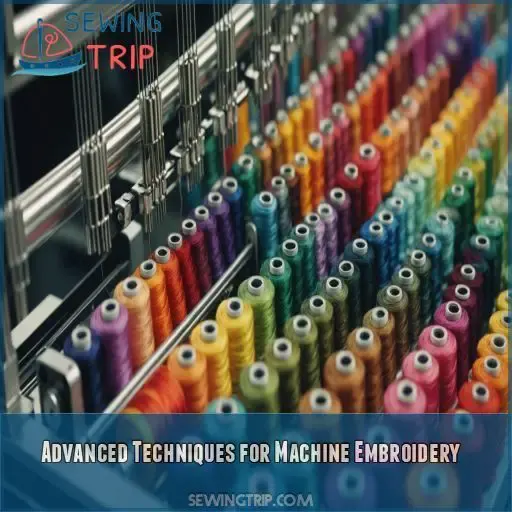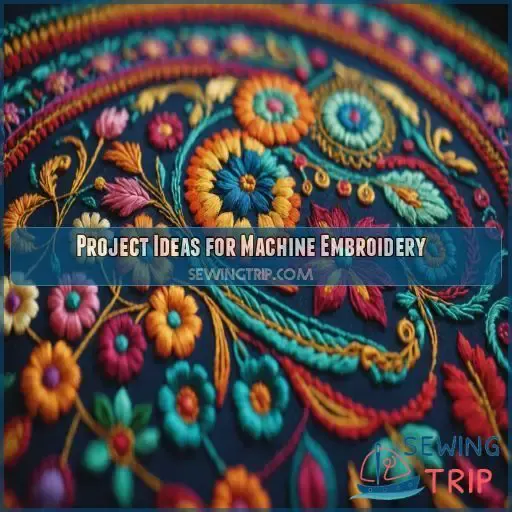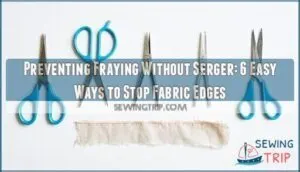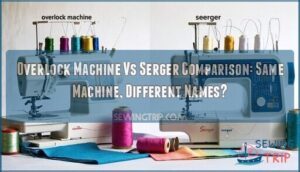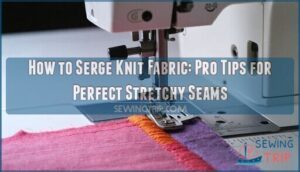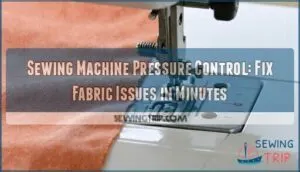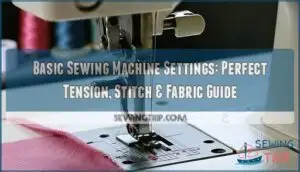This site is supported by our readers. We may earn a commission, at no cost to you, if you purchase through links.
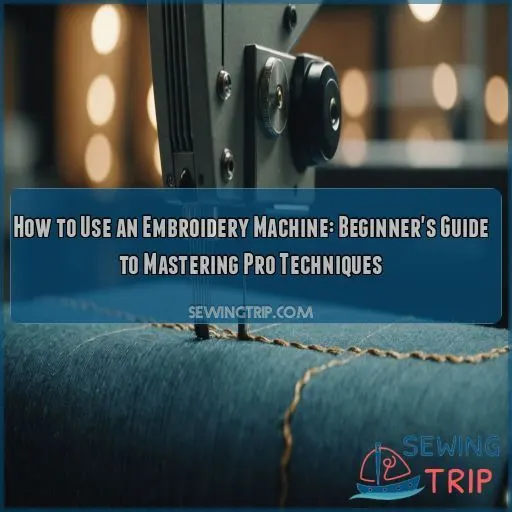 Learning how to use an embroidery machine might seem intimidating, but it’s a breeze once you get the hang of it.
Learning how to use an embroidery machine might seem intimidating, but it’s a breeze once you get the hang of it.
First, choose a machine that fits your budget and project needs.
Then, gather your supplies: stabilizers, needles, and threads.
Set up your machine by threading it properly and attaching the hoop.
Next, load your design and position it on the fabric.
Once everything’s in place, hit start and watch the magic happen!
As you practice, you’ll master hooping techniques, tension adjustments, and troubleshooting common issues.
Before you know it, you’ll be stitching up a storm and creating beautiful, personalized designs.
And who knows? You might just discover some tricks that’ll make even seasoned embroiderers green with envy.
Table Of Contents
- Key Takeaways
- Choosing the Right Embroidery Machine
- Preparing Essential Supplies for Machine Embroidery
- Setting Up Your Embroidery Machine
- Mastering Basic Embroidery Techniques
- Embroidering Like a Pro
- Advanced Techniques for Machine Embroidery
- Project Ideas for Machine Embroidery
- Frequently Asked Questions (FAQs)
- Conclusion
Key Takeaways
- You’ll want to start by choosing the right machine and gathering essential supplies, such as stabilizers, needles, and threads. It’s like assembling your embroidery toolkit – once you’ve got everything in place, you’ll be ready to stitch up a storm!
- Don’t be intimidated by the setup process. Threading your machine and hooping your fabric might seem tricky at first, but with practice, you’ll be doing it in your sleep. Remember, even embroidery professionals were once beginners fumbling with their first hoop!
- Mastering basic techniques is key to embroidery success. You’ll learn to hoop like a pro, load designs onto your machine, and position your embroidery just right. It’s like learning to ride a bike – you’ll wobble through it at first, and soon you’ll be cruising!
- As you gain confidence, you’ll tackle common issues like thread tension and design placement. Before you know it, you’ll be creating custom designs and jazzing up everything from throw pillows to bath towels. Who knows? You might even become the go-to embroidery expert among your friends!
Choosing the Right Embroidery Machine
You’re ready to take the leap and get your own embroidery machine, but with so many options out there, You’re ready to take the leap and get your own embroidery machine, but with so many options out there, choosing the right one, much like selecting a dress form, can be overwhelming.
. Let’s break it down and explore how to evaluate your budget and project needs, research brands and models, compare features and specifications, and consider the all-important embroidery field size.
Evaluating Budget and Project Needs
Kick-start your embroidery journey by evaluating your budget and project needs. Consider the complexity of your projects, desired features, and budget limitations. Be honest about your skill level and the learning curve you’re willing to tackle. Think about the types of embroidery designs you want to create and the software you’ll need to get started.
Researching Brands and Models
When researching brands and models, you’re on a mission to find your perfect embroidery machine match. Start by:
- Checking the brand’s reputation and user reviews to make sure you’re investing in a reliable partner.
- Looking into warranty comparisons to safeguard your purchase.
- Exploring the price range to find a machine that fits your budget and meets your embroidery needs.
Comparing Features and Specifications
Now that you’ve researched brands and models, it’s time to get down to business – comparing features and specifications. Think of it like buying a car: you want to know what’s under the hood. Look for the type and number of stitches, speed settings, thread tension control, and compatibility with your favorite design software.
Considering Embroidery Field Size
When choosing an embroidery machine, consider the embroidery field size – it’s important for your projects. Think of it like a canvas: you want enough space to create your masterpiece. Here are some factors to keep in mind:
- Embroidery hoop size: Will it fit your project dimensions?
- Design size: Can the machine handle large embroidery or is it better suited for small projects?
- Project type: Are you working on embroidery blanks or thick fabrics?
- Versatility: Can the machine adapt to different hoop sizes and project types?
- Future projects: Will the machine’s embroidery field size limit your creativity or give you room to grow?
Preparing Essential Supplies for Machine Embroidery
When you’re ready to get creative with machine embroidery, you need the right tools to make sure your stitching is smooth and your projects look professional. In this section, you’ll learn how to choose the perfect stabilizers, needles, threads, and designs for your projects, setting yourself up for success and avoiding frustrating mistakes.
Machine Embroidery Stabilizers and Their Uses
Now that you’ve chosen your embroidery machine, let’s talk stabilizers! These unsung heroes provide support for your fabric during embroidery. You’ll encounter cut-away, tear-away, wash-away, and heat-away types, each suited for different fabrics and designs. Experiment with various stabilizers to find the perfect match for your project. Remember to test and adjust as needed for a smooth embroidery ride.
Selecting the Right Machine Embroidery Needles
The perfect needle match! To get smooth embroidery, To get smooth embroidery, you need the right machine embroidery needles.
. Here are the key things to think about:
- Choose a needle size that fits your fabric weight and thread type.
- Select from ballpoint, sharp, or universal needle points.
- Match your needle to your embroidery machine and design type.
- Think about the types of cotton fabric you’re working with.
.
- Experiment with different needles for unique textures and effects.
Understanding Thread Types and Weights
Now that you’ve got the right needle, let’s talk thread! With so many types and weights, it can be overwhelming. Start by understanding the basics: rayon and polyester are popular choices, with polyester being more colorfast. Check your thread weight chart to make sure you’re using the right thread for your project. Happy stitching!
Choosing the Right Embroidery Machine Designs
Now that you’ve got your threads in order, it’s time to pick the perfect design!
When choosing embroidery machine designs, consider the complexity of the design, file formats compatible with your machine, and hoop size.
Don’t be afraid to edit designs or create your own using embroidery digitizing software.
Think about stitch types and fabric type to make sure you get a flawless finish.
Setting Up Your Embroidery Machine
Now that you’ve got your essential supplies ready, it’s time to set up your embroidery machine and get stitching! In this section, you’ll learn how to mark your embroidery blanks, hoop your fabric, thread your machine, and attach the hoop – the perfect foundation for creating beautiful embroidery designs.
Marking Embroidery Blanks and Hooping Fabric
Now that you’ve got your supplies ready, it’s time to set up your embroidery machine.
Begin by marking the center of your embroidery blank with a water-soluble pen or chalk wheel.
Then, hoop your fabric, making sure it’s taut but not stretched or distorted.
Choose the right stabilizer and make sure the fabric is centered – this will make all the difference in your design’s outcome.
Threading the Machine and Setting the Needle
Now that you’ve marked your embroidery blank and hooped your fabric, it’s time to thread your machine and set the needle. Don’t worry, it’s easier than threading a needle by hand.
Here are three steps to get you started:
- Choose the right thread: Select a high-quality embroidery thread that matches your fabric and design.
- Wind your bobbin: Follow your machine’s instructions for winding a bobbin, and make sure to leave a little tail to avoid tangles.
- Thread your machine: Guide the thread through the machine’s tension discs and take-up lever, then gently pull it to remove any slack.
Attaching the Hoop and Securing the Fabric
Now that you’ve threaded your machine, it’s time to attach the hoop and secure your fabric. This is where the magic happens! Make sure your fabric is tight and even, with just one layer in the hoop. Here’s a quick reference guide to get you started:
| Hooping Technique | Fabric Tension | Hoop Size |
|---|---|---|
| Tight and Even | Medium to High | Standard 4×4 |
| Loose and Wrinkled | Low to Medium | Large 5×7 |
| Stretched and Distorted | High to Very High | Extra Large 9×5 |
Remember to use the right stabilizer and hooping tools for your fabric type. Happy embroidering!
Turning on the Machine and Changing the Presser Foot
Now that your hoop is securely attached, it’s time to bring your machine to life! Press the power button, and you’ll be greeted by the gentle hum of your embroidery machine. Before you start stitching, make sure you’ve got the right presser foot for the job. Here are three things to check:
- 1. Verify the presser foot is compatible with your fabric type.
- 2. Choose from various presser foot types, such as zigzag or blind hem.
- 3. Refer to your machine’s manual for specific foot change instructions.
Mastering Basic Embroidery Techniques
Now that you’ve set up your embroidery machine, it’s time to get stitching! Mastering basic embroidery techniques is all about understanding how to hoop your fabric and stabilizer, load designs onto the machine, and position your embroidery for perfect results, similar to how one would stabilize bra clasps.
, load designs onto the machine, and position your embroidery for perfect results.
Hooping Fabric and Stabilizer
The fun part – hooping your fabric and stabilizer! To avoid fabric tension issues, choose the right stabilizer type for your fabric, and cut it slightly larger than your hoop. Select a hoop size that allows for comfortable fabric movement. Prevent fabric distortion by gently tightening the hoop, ensuring your fabric is taut but not stretched.
Loading Designs Onto the Machine
Now that you’ve got your fabric and stabilizer hooped, it’s time to load your design onto the machine. Make sure your design file format is compatible with your machine, and use embroidery software to edit or resize as needed. Use a USB stick or card to transfer the design, and follow your machine’s specific loading instructions.
Positioning and Starting the Embroidery
Now that your design is loaded, it’s time to position and start the embroidery. You’re just a few steps away from bringing your design to life.
- Check your hoop and stabilizer for proper alignment
- Use the machine’s controls to position the design where you want it
- Adjust the needle position and thread tension as needed
- Press start and watch your design take shape
Common Beginner Mistakes and Solutions
Now that you’ve got your design positioned and ready to roll, let’s tackle those pesky beginner mistakes. We’ve all been there – wonky hooping, tangled threads, and stabilizers that just won’t cooperate. Don’t worry, friend! With a few tweaks to your thread tension, needle selection, and design placement, you’ll be stitching like a pro in no time.
Embroidering Like a Pro
Now that you’ve mastered the basics of machine embroidery, it’s time to take your skills to the next level and start embroidering like a pro. With a little practice and patience, you’ll be creating stunning designs and tackling complex projects with confidence and ease.
Selecting and Editing Embroidery Machine Designs
Now that you’ve mastered the basics, let’s get creative with selecting and editing embroidery machine designs. You’re not limited to pre-made designs – with the right software, you can create your own custom masterpieces. Here are four ways to take control of your designs:
- Explore design file formats: Understand which formats your machine can read.
- Resize designs: Adjust designs to fit your project’s unique needs.
- Use embroidery software: Utilize software to edit, merge, or create designs from scratch.
- Create custom designs: Use digitizing software or work with embroidery digitizing companies to bring your ideas to life.
Managing Thread Tension and Adjustments
Now that you’ve chosen your designs, let’s talk thread tension. It’s like the Goldilocks of embroidery – not too tight, not too loose, but just right. Here’s a quick guide to help you nail it:
| Tension Issue | Upper Thread | Bobbin Thread |
|---|---|---|
| Too Tight | Puckering | Visible on top |
| Too Loose | Loops | Visible on top |
| Just Right | Smooth | Barely visible |
| Inconsistent | Skipped | Uneven |
| Birdnesting | Tangled mess | Tangled mess |
Solving Common Problems With Embroidery
Tackle embroidery hiccups head-on and watch your projects soar! As you start exploring machine embroidery, you’ll encounter a few bumps along the way. Don’t sweat it—every pro was once a beginner. Here are four common issues you might face:
- Pesky thread breaks
- Mysterious skipped stitches
- Unruly fabric puckering
- Designs that just won’t align
Basic Troubleshooting Tips for Thread Tension and More
| Issue | Quick Fix |
|---|---|
| Loopy stitches | Increase upper tension |
| Puckered fabric | Decrease upper tension |
| Bobbin thread showing | Increase upper tension |
| Upper thread breaks | Decrease upper tension |
| Skipped stitches | Replace needle, rethread |
Advanced Techniques for Machine Embroidery
Once you’ve mastered the basics, it’s time to level up your embroidery game. In this section, we’ll explore advanced techniques that’ll transform you from a novice stitcher to a thread-wielding wizard, capable of creating intricate designs that’ll make your friends say, "Wait, you made that?
Transfer Designs and Techniques
Now that you’ve got the basics down, let’s step up your game with design transfers.
You’ve got options galore!
From tracing methods to embroidery software, there’s a technique for everyone.
Iron-on transfers are a breeze, while water-soluble film lets you create intricate designs.
For the tech-savvy, embroidery digitizing software opens up a world of possibilities.
Mastering Basic Stitches and Motifs
Now that you’ve got the hang of transferring designs, let’s stitch up some magic! Mastering basic stitches and motifs is like learning the ABCs of embroidery – it’s your ticket to endless creativity, once you’ve grasped the basics of straight stitch techniques.
. Here are three must-know stitches to get you started:
- Running stitch: Your go-to for outlines and simple designs
- Satin stitch: Perfect for filling shapes with smooth, glossy texture
- French knot: Adds charming texture and dimension to your work
Creating Custom Embroidery Designs
Now that you’ve got those basic stitches down pat, let’s kick things up a notch and create your own designs.
It’s like being an artist with a needle as your brush!
Start by sketching your ideas on paper, then use embroidery digitizing software to bring them to life.
Play around with different embroidery machine features fonts, color palettes, and design elements.
, color palettes, and design elements.
Don’t be afraid to let your creativity run wild!
Tips for Advanced Embroidery Projects
As you start working on advanced embroidery projects, let your creativity soar! Experiment with free-motion stitching to add unique textures.
Try your hand at applique techniques for dimensional designs.
Don’t shy away from 3D embroidery; it’s a game-changer for adding depth to your work.
Thread painting can transform simple designs into stunning artwork.
And if you’re feeling tech-savvy, explore embroidery digitizing software to create custom patterns that’ll make your projects truly one-of-a-kind.
Project Ideas for Machine Embroidery
Ready to put your embroidery skills to the test? Let’s explore some exciting project ideas that’ll transform your home and help you hone your machine embroidery techniques, from beautiful decor pieces to quick and easy beginner exercises.
Beautiful Decor for the Home and Bathroom
Now that you’ve honed your skills, let’s transform your home with stunning embroidered decor!
Imagine this: a cozy living room adorned with custom throw pillows showcasing your family’s initials.
Or how about jazzing up your bathroom with monogrammed towels?
Don’t stop there!
Create eye-catching wall art, personalized table runners, or even unique gifts for loved ones.
With your embroidery machine, you’re the mastermind behind your home’s beautiful, personalized touch.
Beginners Excercise Create Emplant Craft Quick Wash
Ready to dip your toes into the embroidery pond?
Start with a quick-wash project that’ll have you feeling like a pro in no time.
Choose a simple design, like a flower or monogram, and stitch it onto a washcloth or hand towel.
You’ll get to practice hooping, threading, and basic stitches while creating a practical item.
Before you know it, you’ll be embroidering like a seasoned pro!
Frequently Asked Questions (FAQs)
Is it easy to use an embroidery machine?
You’ll find embroidery machines surprisingly user-friendly. With practice, you’ll be stitching like a pro in no time. Start simple, follow your machine’s guide, and don’t be afraid to experiment. It’s like riding a bike—soon, you’ll cruise!
What are the steps of machine embroidery?
Ready to start machine embroidery? Here’s your roadmap: Prep your fabric, hoop it tight, load your design, thread the machine, and hit start. It’s like painting with thread – you’ll be stitching masterpieces in no time!
What do I need for machine embroidery?
You’ll need a mountain of supplies to conquer machine embroidery! Get stabilizers, special needles, and threads. Don’t forget embroidery designs and a marking tool. With these in your arsenal, you’re ready to create stunning masterpieces!
Is embroidery easy for beginners?
You’ll face a learning curve, but don’t let that scare you! With patience and practice, you’ll be stitching like a pro in no time. Start small, embrace mistakes, and soon you’ll be hooked on embroidery’s creative magic.
How to clean and maintain an embroidery machine?
You’ll want to clean your embroidery machine regularly. Brush out lint, oil moving parts, and change needles often. Don’t forget to dust the bobbin area and feed dogs. It’s like giving your trusty stitching companion a spa day!
Can I embroider on pre-made garments?
You can jazz up pre-made garments with embroidery. Just hoop ’em carefully, use the right stabilizer, and position your design. It’s like giving your clothes a mini makeover – fun and totally doable!
What causes thread breakage during embroidery?
Ever had your thread snap mid-stitch? It’s frustrating! Thread breakage can be caused by incorrect tension, dull needles, or low-quality thread. You’ll also want to check for burrs in your machine’s parts and make sure you’re threading it correctly.
How to digitize my own embroidery designs?
To digitize your own embroidery designs, you’ll need specialized software. Start by sketching your idea, then import it into the program. Use tools to trace and define stitch types, adjusting density and direction. It’s like digital coloring!
Can I combine embroidery with other sewing techniques?
You can jazz up your projects by mixing embroidery with quilting, appliqué, or even painting. It’s like adding sprinkles to your sewing sundae – the possibilities are endless! Just let your creativity run wild and experiment.
Conclusion
Did you know that 45% of embroidery enthusiasts started as complete beginners?
You’re well on your way to joining their ranks!
Learning how to use an embroidery machine opens up a world of creative possibilities.
With practice, you’ll master hooping, tension, and design placement like a pro.
So, don’t be afraid to experiment and make mistakes; they’re your best teachers.
Before long, you’ll be stitching up a storm and wondering why you didn’t start sooner!

